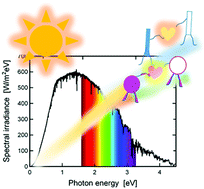Ground-state charge transfer for NIR absorption with donor/acceptor molecules: interactions mediated via energetics and orbital symmetries†
Abstract
The interactions between electron donors (D) and acceptors (A) of organic semiconducting molecules are of great interest to organic electronics, e.g. electrical doping of organic semiconductors (OSCs), photo-generation of charges in organic solar cells, and light-emitting/detecting devices based on OSCs. A blend of D/A OSC is typically characterized by weak van der Waals interactions or integer charge transfer (ICT) between neighboring D/A molecules. In between these two scenarios of physical blends and ICT complexes, orbital hybridization between adjacent D/A molecules serves as a third alternative, characterized by an in situ formation of a ground state complex featuring partial charge transfer between participating donor and acceptor molecules. In this work is presented a comprehensive experimental study on partial charge-transfer complex (CPX) formed via orbital hybridization. Thiophenes and phthalocyanines are used as electron donors, while acceptor molecules of different geometries and electron affinities are employed with the aim to clarify how orbital symmetry, energy level alignment and steric hindrance affect orbital hybridization and subsequent tuning of the optical band-gap into the near infrared (NIR) region.

- This article is part of the themed collection: 2016 Journal of Materials Chemistry C Hot Papers


 Please wait while we load your content...
Please wait while we load your content...